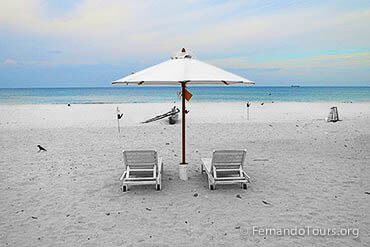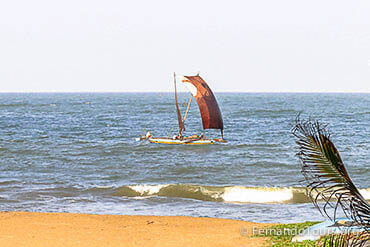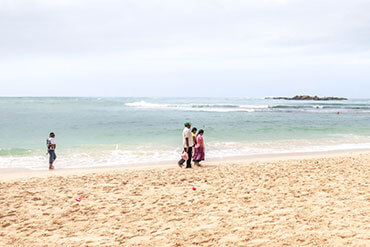
Towns & Cities
Trincomalee, located on the northeastern coast of Sri Lanka, is a coastal city known for its natural beauty, historic significance, and vibrant culture. Here are some key features of Trincomalee:
1. Natural Harbors: Trincomalee is home to one of the world’s largest natural harbors, making it historically significant. The harbor has been coveted by various maritime powers throughout history and has played a crucial role in trade and naval activities.
2. Beaches: The city boasts pristine beaches with soft golden sand and turquoise waters. Some popular beaches include Nilaveli Beach and Uppuveli Beach, known for their tranquility and scenic surroundings. These beaches offer opportunities for water sports, sunbathing, and relaxation.
3. Pigeon Island National Park: Just off the coast of Nilaveli, Pigeon Island is a marine national park known for its coral reefs and diverse marine life. Snorkeling and diving enthusiasts can explore the vibrant underwater world and encounter a variety of tropical fish.
4. Koneswaram Temple: Perched on Swami Rock overlooking the Indian Ocean, Koneswaram Temple is a significant Hindu temple with a rich history. The temple complex includes intricate sculptures, colorful shrines, and a sacred pond. The site offers breathtaking views of the coastline.
5. Fort Frederick: Built by the Portuguese in the 17th century and later expanded by the Dutch and the British, Fort Frederick is a historic fort that provides insights into the colonial past of Trincomalee. The fort houses a Hindu temple and a colonial-era British military cemetery.
6. Hot Springs: The Kanniya Hot Springs, located a short distance from Trincomalee, is a set of seven hot springs believed to have therapeutic properties. Visitors often enjoy bathing in the natural hot water pools.
7. Cultural Diversity: Trincomalee is characterized by its cultural diversity, with a mix of Sinhalese, Tamil, and Muslim communities. This diversity is reflected in the local cuisine, festivals, and religious practices.
8. Whale Watching: Trincomalee is a popular starting point for whale-watching excursions in the nearby seas. The region is known for sightings of blue whales, sperm whales, and dolphins, offering an unforgettable marine experience.
Trincomalee, with its blend of history, culture, and natural wonders, is a destination that appeals to those seeking both relaxation and exploration along Sri Lanka’s less-visited northeastern coast.

Wildlife & Nature
Pigeon Island National Park, situated off the eastern coast of Sri Lanka near Nilaveli, is a marine national park renowned for its vibrant coral reefs, diverse marine life, and pristine beaches. Here are key features of Pigeon Island National Park:
1. Marine Biodiversity: Pigeon Island is celebrated for its rich marine biodiversity, making it a haven for snorkelers and divers. The coral reefs surrounding the island host a variety of colorful corals, including both hard and soft corals.
2. Snorkeling and Diving: The park offers exceptional snorkeling and diving opportunities, allowing visitors to explore the underwater wonders. Snorkelers can encounter an array of marine species, including reef fish, sea turtles, and various coral formations. Divers may explore deeper areas for a more immersive experience.
3. Coral Gardens: Pigeon Island features stunning coral gardens that attract marine enthusiasts. The coral formations provide habitat and sustenance for a diverse range of marine life, contributing to the ecological significance of the park.
4. Rock Pigeon Colonies: The island is named after the rock pigeon colonies that inhabit it. While the pigeons are a notable aspect of the park, the marine environment and coral reefs are the primary attractions for visitors.
5. Two Islands: Pigeon Island National Park is composed of two islands: Large Pigeon Island and Small Pigeon Island. The larger island is open to visitors, while access to the smaller island may be restricted to protect sensitive nesting sites.
6. White Sandy Beaches: Both islands boast pristine white sandy beaches, providing visitors with picturesque settings for relaxation and picnics. The clear blue waters and gentle waves contribute to the idyllic coastal ambiance.
7. Coral Conservation: Efforts are made to conserve and protect the coral reefs within the national park. Visitors are encouraged to follow responsible tourism practices, such as not touching or damaging the corals, to preserve the delicate marine ecosystem.
8. Marine Conservation Awareness: Pigeon Island National Park serves as an educational platform for marine conservation. Signage and information provided in the park aim to raise awareness about the importance of protecting coral reefs and the marine environment.
To visit Pigeon Island National Park, one can take a boat ride from Nilaveli, and the island is typically open for day visits. It’s a destination that appeals to nature lovers, snorkelers, and anyone seeking to experience the beauty of Sri Lanka’s underwater world.
Please note there is an entrance fee and tickets for boat hire.

Towns & Cities
The beach town Negombo is located on the west coast of Sri Lanka, very close to Colombo Airport, and therefore it is often the first and the last town tourists stays when they visit Sri Lanka.
Negombo has long wide sandy beaches and lots of hotels, restaurants and shops along the main road. The town is known for the fish market and the many fisher boats.
Two times a week there is a market, where you can buy everything from vegetables to clothes and kitchen knifes.

Towns & Cities
Unawatuna is known for the fine sandy beaches, and is a beloved town for beach holidays.
In Unawatuna You can visit the Buddha temple, located on top of a cliff with a spectacular view.



